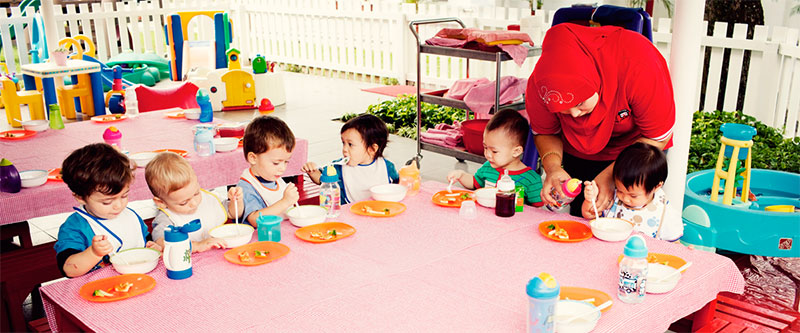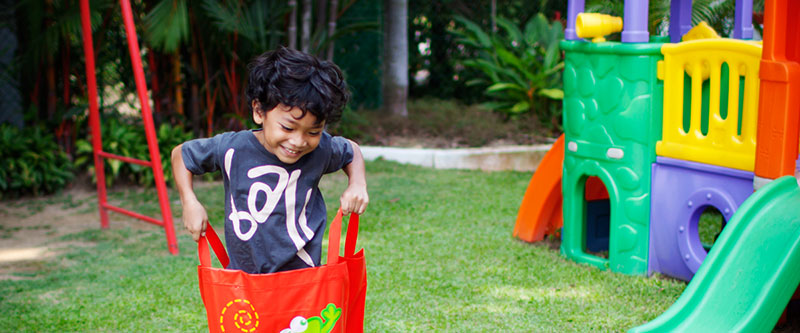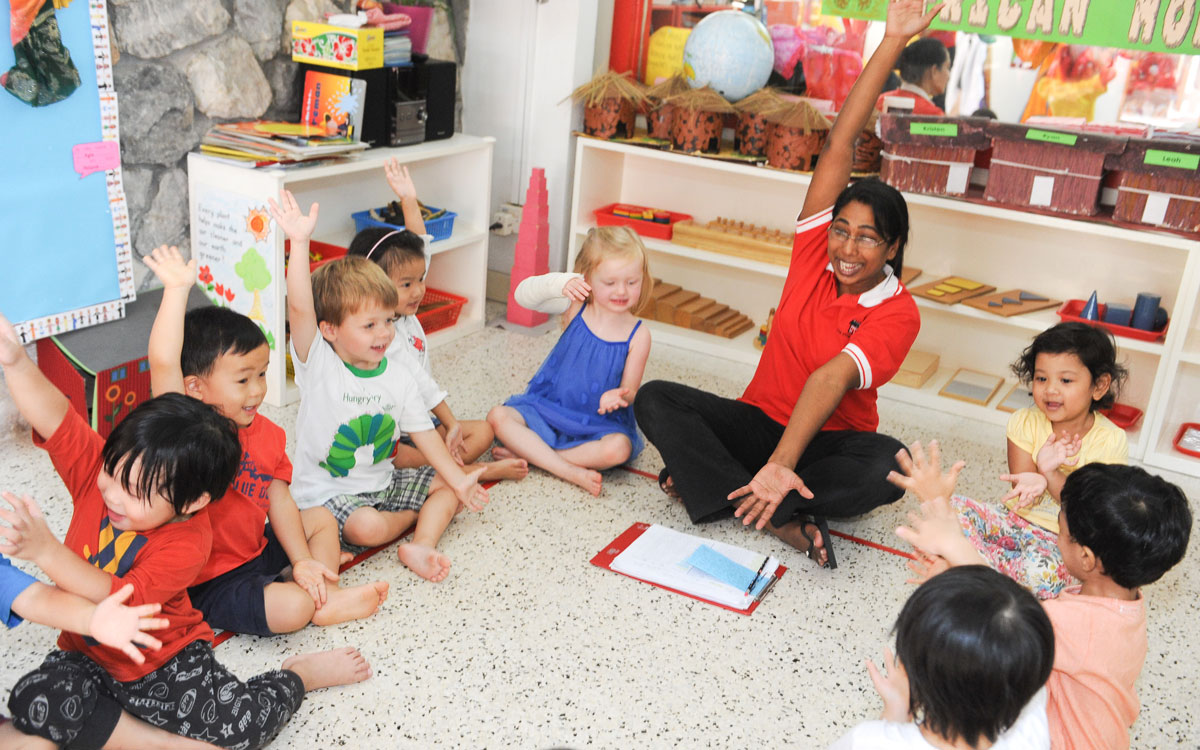Montessori learning through The children’s house
Every child is unique and is filled with an enthusiasm to explore the world around them. Each day in a child’s life is filled with the curiosity to learn something new. Hence, it is important that they find a caring environment that guides them on their individual path and inculcates a love for learning in them. This can only happen in a prepared environment where the child gets to work with materials that entice and engross his mind.
The children’s house recognises the uniqueness of your child and is as passionate about your little one as you are. Children in their first stage of development from 0 to 6 years are like learning sponges. They have incredible powers of absorption and every new thing that they experience during the early years is crucial for their physical, social, emotional and intellectual development.

Creating a loving and secure environment
The children’s house focuses on getting it right from the very beginning. We understand that your child needs to go through a separation from the caregiver in order to socialise and enter into a new routine of going to school. Hence, the Infant and the Pre-tots programme aim to provide a secure and loving environment for your child through a foundation of Caregiving, Play and Attachment in the curriculum.
While caregiving ensures respectful and responsive interactions with the infants and pre-tots, play greatly helps the children learn unconsciously. The programme includes engaging activities like Tots Art, Tots Music, Tots Read, Tots Gym, Tots Sensory Play and Sunshine Tots. Through a wide range of interesting activities, your child will acquire cognitive abilities, language skills, improved physical abilities, social and emotional skills required to be an active part of this world. Every activity is designed exclusively to stimulate the curiosity of your little ones as he progresses to the Toddler age group.
A child-centred approach to education
The environment at The children’s house is completely centred around your child. The Montessori method of teaching at Toddler, Preschool and Kindergarten levels provide a nurturing and non-competitive environment that focuses on the individual needs and development of every child. The school ensures that your child gets all the care and attention by keeping low teacher child ratios coupled with well-planned classrooms to avoid overcrowding. Trust is fostered through care and participation in activities like putting away toys and returning materials back to their places.
It encourages self-education, where children learn in a prepared environment, that provides them with activities and presents opportunities for exploration, investigation and problem-solving. Children are given the freedom to choose their activity and have the responsibility of returning the materials to their places. These experiences not only give the child a sense of security but also stimulate intelligence and promote physical and psychological development. Their natural desire to succeed is encouraged by repetitive activities which help them perfect the art until they achieve a great sense of satisfaction and joy.

Learning through a variety of engaging materials
Children are provided with an encouraging environment with materials aimed at covering all areas of development. The didactic apparatus is specially designed for every level of childhood development. They start from being simple and gradually move on to more complex materials. For example from colour box 1 (primary colours) for level 1 to colour box 2 (secondary colours) for level 2 and colour box 3 (shades of secondary colours) for level 3. In this way, children learn to advance smoothly from one level to another without being perplexed by missing links.
Programmes at every level in The children’s house aim to prepare your child for a smooth transition to the next level. Each activity is carefully designed to enhance the all-round development of your child. Given the fact that 90% of the brain development of a child happens before the age of five, it is important to understand that preschool is much more than just playing. Children start with concrete experiences and move on to abstract at a later stage. Concrete thinking is important for mental development as it provides a base for abstract thinking. Concrete experiences not only give children the ability to reason beyond limits but also help them interpret better.
Rich learning experience through Montessori
By working independently on a wide variety of materials in a Montessori environment, children learn to make choices and develop problem-solving skills as they advance from one level to another. Their young minds first learn to explore, gradually developing the ability for abstract thinking. While the basic educational benefits of preschool (such as literacy and numeracy) are tangible, the advances children achieve towards becoming well-rounded individuals are truly invaluable.
The children’s house provides your child with an environment in which a skilled observer (teacher) gives him the freedom needed to orientate his personality while helping him maintain self-control. Above all, through all the activities we not only respect the individuality of your child but they also learn to respect the teachers and other children.


[…] working independently on a wide variety of materials in a Montessori environment, children learn to make choices and develop problem-solving skills as they advance from one level […]
[…] working independently on a wide variety of materials in a Montessori environment, children learn to make choices and develop problem-solving skills as they advance from one level […]
[…] Now that you have a clearer understanding of how preschool can set the stage for your child’s future successes, check out the Montessori approach at TCH, and the significant benefits it offers preschoolers! Click here. […]
[…] Now that you have a clearer understanding of how preschool can set the stage for your child’s future successes, check out the Montessori approach at TCH, and the significant benefits it offers preschoolers! Click here. […]
[…] Now that you have a clearer understanding of how preschool can set the stage for your child’s future successes, check out the Montessori approach at TCH, and the significant benefits it offers preschoolers! Click here. […]
[…] Now that you have a clearer understanding of how preschool can set the stage for your child’s future successes, check out the Montessori approach at TCH, and the significant benefits it offers preschoolers! Click here. […]
[…] Now that you have a clearer understanding of how preschool can set the stage for your child’s future successes, check out the Montessori approach at TCH, and the significant benefits it offers preschoolers! Click here. […]
[…] Now that you have a clearer understanding of how preschool can set the stage for your child’s future successes, check out the Montessori approach at TCH, and the significant benefits it offers preschoolers! Click here. […]
[…] Now that you have a clearer understanding of how preschool can set the stage for your child’s future successes, check out the Montessori approach at TCH, and the significant benefits it offers preschoolers! Click here. […]
[…] Now that you have a clearer understanding of how preschool can set the stage for your child’s future successes, check out the Montessori approach at TCH, and the significant benefits it offers preschoolers! Click here. […]
[…] working independently on a wide variety of materials in a Montessori environment, children learn to make choices and develop problem-solving skills as they advance from one level […]
[…] working independently on a wide variety of materials in a Montessori environment, children learn to make choices and develop problem-solving skills as they advance from one level […]
[…] working independently on a wide variety of materials in a Montessori environment, children learn to make choices and develop problem-solving skills as they advance from one level […]
[…] Now that you have a clearer understanding of how preschool can set the stage for your child’s future successes, check out the Montessori approach at TCH, and the significant benefits it offers preschoolers! Click here. […]
[…] Now that you have a clearer understanding of how preschool can set the stage for your child’s future successes, check out the Montessori approach at TCH, and the significant benefits it offers preschoolers! Click here. […]
[…] Now that you have a clearer understanding of how preschool can set the stage for your child’s future successes, check out the Montessori approach at TCH, and the significant benefits it offers preschoolers! Click here. […]
[…] Now that you have a clearer understanding of how preschool can set the stage for your child’s future successes, check out the Montessori approach at TCH, and the significant benefits it offers preschoolers! Click here. […]
[…] Now that you have a clearer understanding of how preschool can set the stage for your child’s future successes, check out the Montessori approach at TCH, and the significant benefits it offers preschoolers! Click here. […]
[…] Now that you have a clearer understanding of how preschool can set the stage for your child’s future successes, check out the Montessori approach at TCH, and the significant benefits it offers preschoolers! Click here. […]
[…] Now that you have a clearer understanding of how preschool can set the stage for your child’s future successes, check out the Montessori approach at TCH, and the significant benefits it offers preschoolers! Click here. […]
[…] out the Montessori approach at TCH, and the significant benefits it offers preschoolers! Click here. Post Views: 1 education, preschool education, […]
[…] Now that you have a clearer understanding of how preschool can set the stage for your child’s future successes, check out the Montessori approach at TCH, and the significant benefits it offers preschoolers! Click here. […]
[…] As a parent, you may be questioning the benefits of early childhood education at such a young age. Isn’t a comfortable home a more suitable environment for a child’s growth? How does preschool education make a difference in my child’s development? To find answers to all your questions, we elaborate on how children develop in their cognitive, emotional, social and physical abilities in the early years. 1 Physical Development Children experience exponential growth in the early stages of childhood. However, physical development refers to a child’s ability to control their body including the muscular system and nervous system. Gross-motor skills refer to the development of large muscle movements such as the arms and legs, while fine-motor skills refer to precise movements of the hands and fingers. A preschool environment provides many learning opportunities for a child’s overall development. Aside from a set curriculum, children are also given opportunities to play. The balance between organised learning and unstructured play is essential to enhance the learning and developmental growth of young children. Unstructured play ‘Playtime’ or unstructured play may be understood as fun to parents. However, playtime is a critical time for children to learn interaction with their peers, develop observation skills, make mistakes (while learning from them), and build on their strength in their core, arms and legs! Guided play, arts and crafts Building a solid foundation for a child to excel in formal education starts with arts and crafts. Painting, colouring and building crafts aren’t just another fun activity, it’s a great opportunity for children to build on fine motor skills. 2 Cognitive Development Cognitive development refers to the ability of a child to think, perceive and understand the world around them. In the early days, infants were believed to lack any form of thought until they learned a language. Today, it is a commonly known fact that babies start learning from the time they take their first breath, constantly trying to make sense of their world. There is no doubt that a child’s mind is like a sponge, absorbing everything that it can from its surroundings. In the book ‘The Absorbent Mind’, Italian physician and world-renowned educator Maria Montessori speaks about the absorbing power of a child’s mind in the early years. She remarks, “….the tiny child’s absorbent mind finds all its nutriment in its surroundings. Here it has to locate itself and build itself up from what it takes in. Especially at the beginning of life must we, therefore, make the environment as interesting and attractive as we can. The child, as we have seen, passes through successive phases of development and in each of these his surroundings have an important – though different – part to play.” (The Absorbent Mind, p. 88) In a preschool environment, learning goals are set for each class. As the children work with each other and an educator, their ability to think and reason begin to develop as they analyse, compare, organise and develop solutions to problems. While cognitive development is unique to each child, preschool educators use these milestones to better gauge a child’s abilities and structure the learning process for them. 3 Emotional Development Emotions are the emergence of complex feelings that affect one’s thoughts, behaviours and moods. In emotional development, a child begins to understand, express and regulate emotions within their capacity to fully interact with others. At home, a child takes centre stage and may not be able to experience what it’s like to share toys. But at preschool, a child will explore and engage with other children, collaborate on goals and learn to manage their emotions positively. They begin to form and sustain good relationships with their community, by learning to listen, understand and express themselves with confidence. Through these small but meaningful acts, a child can gain and boost their confidence while building trust with their peers. This ‘trust’ enhances their understanding of another’s emotions or ‘empathy’, boosting their emotional development. 4 Social Development The process by which a child learns to interact with their environment and those around them is called social development, and it often comes hand-in-hand with emotional growth. As a child develops individuality and social skills, they learn to communicate their wants and needs, resolve conflicts and build a positive attitude. Preschool environments provide many of these opportunities for children throughout the day as the children learn, work and play with each other. The early years of childhood education rely heavily on creating a warm and trusting relationship between a child and their community. Those of whom children interact with the most: parents, peers and caregivers, make up their community. By providing a positive and loving environment, children build a sense of self-confidence. Another important factor of a child’s overall development and self-esteem is the prepared environment. A child should be able to complete a task with full confidence, which is why every tool meant for a child should be within reach. This vital component means that the classroom or play area is conducive to learning while providing opportunities for a child to engage with others. Now that you have a clearer understanding of how preschool can set the stage for your child’s future successes, check out the Montessori approach at TCH, and the significant benefits it offers preschoolers! Click here. […]
[…] Now that you have a clearer understanding of how preschool can set the stage for your child’s future successes, check out the Montessori approach at TCH, and the significant benefits it offers preschoolers! Click here. […]
[…] Now that you have a clearer understanding of how preschool can set the stage for your child’s future successes, check out the Montessori approach at TCH, and the significant benefits it offers preschoolers! Click here. […]
[…] Now that you have a clearer understanding of how preschool can set the stage for your child’s future successes, check out the Montessori approach at TCH, and the significant benefits it offers preschoolers! Click here. […]
[…] Now that you have a clearer understanding of how preschool can set the stage for your child’s future successes, check out the Montessori approach at TCH, and the significant benefits it offers preschoolers! Click here. […]
[…] Now that you have a clearer understanding of how preschool can set the stage for your child’s future successes, check out the Montessori approach at TCH, and the significant benefits it offers preschoolers! Click here. […]
[…] Now that you have a clearer understanding of how preschool can set the stage for your child’s future successes, check out the Montessori approach at TCH, and the significant benefits it offers preschoolers! Click here. […]